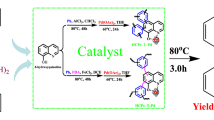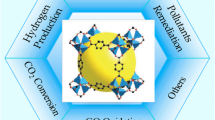Abstract
Heterogeneous solid base catalysts have attracted widespread attention for various reactions from the perspective of green and economy chemistry due to their advantages such as low corrosiveness, high reaction efficiency, and easy separation. The unique properties of polyacrylonitrile fibers (PANF) such as good mechanical strength and a surface rich in cyanine and economy make them suitable catalytic supports. Herein, potassium oxide was introduced into PANF by redox strategy. Characterization using XRD, FT-IR, solid-state 13C NMR, XPS, SEM, CO2-TPD, etc. confirmed the successful preparation of this heterogeneous base catalyst and the participation of PANF in the redox process of KNO3 to promote the decomposition of KNO3. The acquired catalyst showed obvious activity for the oxidation of methylene compounds and the yield of fluorenones can reach 100% at 100 °C. This strategy provides a new development path for the application of PANF and the synthesis of heterogeneous bases.
Graphical Abstract







Similar content being viewed by others
References
Raytchev PD, Bendjeriou A, Dutasta J-P, Martinez A, Dufaud V (2011) Adv Synth Catal 353:2067–2077
Puthiaraj P, Pitchumani K (2014) Chemistry 20:8761–8770
Graciani J, Mudiyanselage K, Xu F, Baber AE, Evans J, Senanayake SD, Stacchiola DJ, Liu P, Hrbek J, Sanz JF (2014) Science 345:546–550
Lee AF, Bennett JA, Manayil JC, Wilson K (2014) Chem Soc Rev 43:7887–7916
Wilson K, Lee AF (2012) Catal Sci Technol 2:884–897
Luo Q-X, Song X-D, Ji M, Park S-E, Hao C, Li Y-Q (2014) Appl Catal A 478:81–90
Sun LB, Gu FN, Chun Y, Yang J, Wang Y, Zhu JH (2008) J Phys Chem C 112:4978–4985
Lu X, Shi S, Zhu G, Zhao L, Wang M, Gao J, Du Z, Xu J (2020) ChemistrySelect 5:549–553
Sun Y-H, Sun L-B, Li T-T, Liu X-Q (2010) J Phys Chem C 114:18988–18995
Sun L-B, Sun Y-H, Liu X-D, Zhu L, Liu X-Q (2014) Curr Org Chem 18:1296–1304
Wu ZY, Jiang Q, Wang YM, Wang HJ, Sun LB, Shi LY, Xu JH, Wang Y, Chun Y, Zhu JH (2006) Chem Mater 18:4600–4608
Zhu G, Shi S, Liu M, Zhao L, Wang M, Zheng X, Gao J, Xu J (2018) ACS Appl Mater Interfaces 10:12612–12617
Kawabata H, Hayashi M (2004) Tetrahedron Lett 45:5457–5459
Hayashi E, Tamura T, Aihara T, Kamata K, Hara M (2022) ACS Appl Mater Interfaces 14:6528–6537
Zhou L, Lu T, Xu J, Chen M, Zhang C, Chen C, Yang X, Xu J (2012) Microporous Mesoporous Mater 161:76–83
Mahyari M, Laeini MS, Shaabani A (2014) Chem Commun (Camb) 50:7855–7857
Nie S, Wang J, Huang X, Niu X, Zhu L, Yao X (2018) ACS Appl Nano Mater 1:6567–6574
Kuwahara Y, Yoshimura Y, Yamashita H (2017) Dalton Trans 46:8415–8421
Gibson LT (2014) Chem Soc Rev 43:5173–5182
Zhang J, Li P, Yang Y, Ai W, Liu Y, Zhang W (2022). ChemistrySelect. https://doi.org/10.1002/slct.202201247
Li P, Du J, Xie Y, Tao M, Zhang W-Q (2016) ACS Sustain Chem Eng 4:1139–1147
Li G, Xiao J, Zhang W (2012) Green Chem 14:2234–2242
Farsani RE, Raissi S, Shokuhfar A, Sedghi A (2009) Int J Mech Mechatron Eng 3:161–164
Li P, Liu Y, Wang L, Tao M, Zhang W (2018) J Appl Polym Sci 135:45992
Sun LB, Gong L, Liu XQ, Gu FN, Chun Y, Zhu JH (2009) Catal Lett 132:218–224
Li P, Liu Y, Cao J, Tao M, Zhang W (2017) ChemCatChem 9:3725–3732
Zhang X, Ji X, Jiang S, Liu L, Weeks BL, Zhang Z (2011) Green Chem 13:1891–1896
Shi S, Liu M, Zhao L (2017) Chemistry 12:2404–2409
Zhao L, Shi S, Liu M, Zhu G, Wang M, Du W, Gao J, Xu J (2018) Green Chem 20:1270–1279
Zhang C, Wang F (2023) Chem Rev 123:4510–4601
Zhang C, Wang F (2017) Chin J Catal 38:1102–1107
Tian H-R, Liu Y-W, Zhang Z, Liu S-M, Dang T-Y, Li X-H, Sun X-W, Lu Y, Liu S-X (2020) Green Chem 22:248–255
Acknowledgements
This work was supported in part by the following funds: National Key Research and Development Program of China (Grant No. 2022YFA1504900), National Natural Science Foundation of China (Grant Nos. 22072147, 22372168), the Youth Innovation Promotion Association, the Chinese Academy of Sciences (Grant No. 2021178) and Dalian Innovation Support Plan for High Level Talents (Grant No. 2020RT10). Thanks to Prof. Jie Xu and Prof Jin Gao for their guidance and help.
Funding
Funding was provided by Youth Innovation Promotion Association, the Chinese Academy of Sciences (Grant No. 2021178), National Natural Science Foundation of China (Grant Nos. 22072147, 22372168), National Key Research and Development Program of China (Grant No. 2022YFA1504900), Dalian Innovation Support Plan for High Level Talents (Grant No. 2020RT10).
Author information
Authors and Affiliations
Contributions
SS and XW designed the research. XZ performed the catalytic reaction, established analysis method and completed the paper. YW, XF, JC, XG, WY participated in beneficial discussions. General guidance was done by SS. All authors reviewed and commented on the manuscript.
Corresponding authors
Ethics declarations
Conflict of interest
The authors declare no competing financial interest.
Additional information
Publisher's Note
Springer Nature remains neutral with regard to jurisdictional claims in published maps and institutional affiliations.
Supplementary Information
Below is the link to the electronic supplementary material.
Rights and permissions
Springer Nature or its licensor (e.g. a society or other partner) holds exclusive rights to this article under a publishing agreement with the author(s) or other rightsholder(s); author self-archiving of the accepted manuscript version of this article is solely governed by the terms of such publishing agreement and applicable law.
About this article
Cite this article
Zheng, X., Wang, Y., Feng, X. et al. Generation of Strong Basic Sites on Polyacrylonitrile Fiber as Catalysts for Oxidation of Methylene Compounds. Catal Lett (2024). https://doi.org/10.1007/s10562-024-04633-x
Received:
Accepted:
Published:
DOI: https://doi.org/10.1007/s10562-024-04633-x




